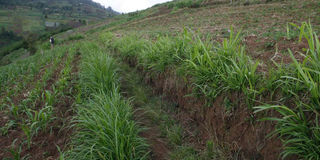Little known Napier grass could cut greenhouse gas emissions reveals study

Napier grass on native grasslands disturbs soil-less and produced fewer emissions than planting maize. PHOTO | SULEIMAN MBATIAH | NATION MEDIA.
Growing and using Napier as fodder in the farm could reduce pressure on forests and reduce greenhouse gas emissions, according to new research. In the study which was published in Global Change Biology, the scientists modelled the impact on greenhouse gas emissions and efficiency of three scenarios for feeding nutrient-rich diets to dairy cows in Kenya: feeding cows on either silage made from maize grown locally or on a cultivated African Napier grass grown on existing grassland, or on a mixture of the two. Using more fertilisers and fodder for increasing yields increases greenhouse gas emissions, according to research from the Centre for International Forestry Research in Kenya, Lancaster, and Wageningen Universities. There are 2 million smallholder dairy farmers in Kenya, who own farms with ten cows or fewer, usually feed their livestock on a mixture of wild grasses grown on local grassland.
REDUCED CAPABILITY
This reduces a forest’s ability to act as a carbon sink by removing vegetation and slows the speed at which forests grow again after it has been cleared. In this, all three diets included small amounts of concentrated feed imported into the farms to feed livestock during the dry season. Maize yield per hectare was increased by adding fertiliser.
Planting the perennial Napier grass on native grasslands disturbs soil-less and produced fewer emissions than planting maize, and is only fertilised with manures. The researchers found all three nutrient-rich diets increased milk production per cow by between 44 and 51 per cent. While the Napier and silage combination reduced greenhouse gas emissions slightly per unit of milk, researchers found that only the Napier grass diet reduced overall emissions by 2.5 per cent, dramatically reducing emissions per kg of milk produced.



